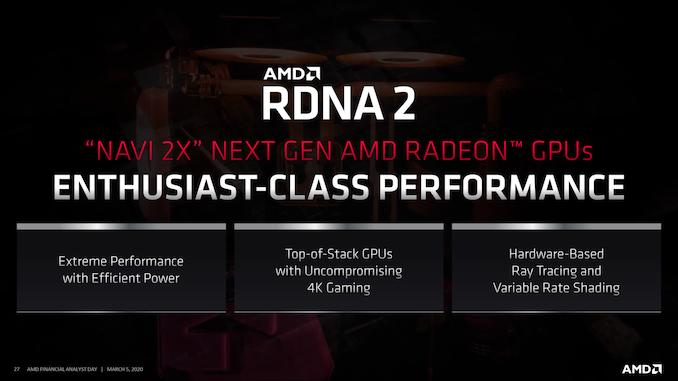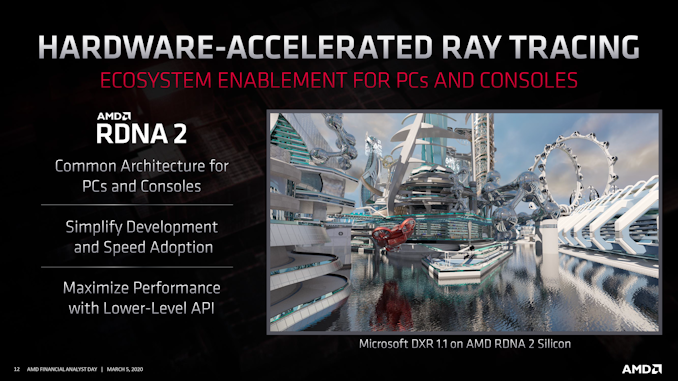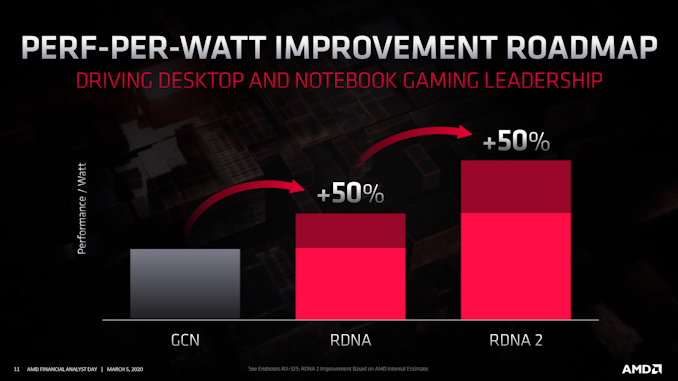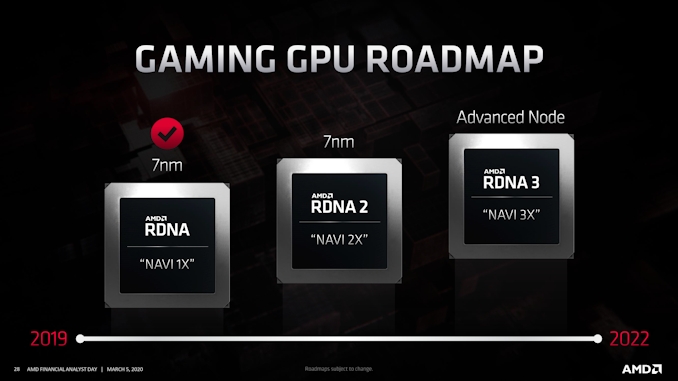AMD's RDNA 2 Gets A Codename: “Navi 2X” Comes This Year With 50% Improved Perf-Per-Watt
by Ryan Smith on March 5, 2020 5:45 PM EST
While AMD’s Financial Analyst Day is first and foremost focused on the company’s financial performance – it’s right there in the title – this doesn’t stop the company from dropping a nugget or two of technical information along the way, to help excite investors on the future of the company.
One such nugget this year involves AMD’s forthcoming RDNA 2 family of client GPUs. The successor to the current RDNA (1) “Navi” family, RDNA 2 has been on AMD’s roadmap since last year. And it’s been previously revealed that, among other things, it will be the GPU architecture used in Microsoft’s forthcoming Xbox Series X gaming console. And while we’re still some time off from a full architecture reveal from AMD, the company is offering just a few more details on the architecture.
First and foremost, RDNA 2 is when AMD will fill out the rest of its consumer product stack, with their eye firmly on (finally) addressing the high-end, extreme performance segment of the market. The extreme high end of the market is small in volume, but it’s impossible to overstate how important it is to be seen there – to be seen as competing with the best of the best from other GPU vendors. While AMD isn’t talking about specific SKUs or performance metrics at this time, RDNA 2 will include GPUs that address this portion of the market, with AMD aiming for the performance necessary to deliver “uncompromising” 4K gaming.
But don’t call it "Big Navi". RDNA 2 isn’t just a series of bigger-than-RDNA (1) chips. The GPUs, which will be the codename “Navi 2X” family, also incorporate new graphics features that set them apart from earlier products. AMD isn’t being exhaustive here – and indeed they’re largely already confirming what we know from the Xbox Series X announcement – but hardware ray tracing as well as variable rate shading are on tap for RDNA 2. This stands to be important for AMD at multiple levels, not the least of which is closing the current feature gap with arch-rival NVIDIA.
And AMD didn’t stop there, either. Even to my own surprise, AMD isn’t just doing RDNA (1) with more features; RDNA 2 will also deliver on perf-per-watt improvements. All told, AMD is aiming for a 50% increase in perf-per-watt over RDNA (1), which is on par with the improvements that RDNA (1) delivered last year. Again speaking at a high level, these efficiency improvements will come from several areas, including microarchitectural enhancements (AMD even lists improved IPC here), as well as optimizations to physical routing and unspecified logic enhancements to “reduce complexity and switching power.”
Process nodes will also play some kind of a role here. While AMD is still going to be on a 7nm process here – and they are distancing themselves from saying that they'll be using TSMC’s EUV-based “N7+” node – the company has clarified that they will be using an enhanced version of 7nm. To what extent those enhancements are we aren’t sure (possibly using TSMC’s N7P?), but AMD won’t be standing still on process tech.
This strong focus on perf-per-watt, in turn, will be a key component of how AMD can launch itself back into being a fully viable, top-to-bottom competitor with NVIDIA. While AMD is already generally at parity with NVIDIA here, part of that advantage comes from an atypical advantage in manufacturing nodes that AMD can’t rely on keeping. NVIDIA isn’t standing still for 2020, and neither can AMD. Improving power efficiency for RDNA 2 (and beyond) will be essential for convincingly beating NVIDIA.
Overall, AMD has significant ambitions with RDNA 2, and it shows. The architecture will be the cornerstone of a generation of consoles, and it will be AMD’s first real shot in the last few years at taking back the flagship video card performance crown. So we’re eagerly awaiting to see what else RDNA 2 will bring to the table, and when this year the first video cards based on the new architecture will begin shipping.














46 Comments
View All Comments
Spunjji - Friday, March 13, 2020 - link
"That's completely wrong. Power efficiency is measured as the work done / energy used. If you clock your big beast at a low clock you get fantastic efficiency, but that is useless if you then have the performance of the smallest chip made by the competitors that consumes as much but costs 1/10th."You're exaggerating here. Radeon VII is a great example of a design that stinks at its default clocks and voltages, but when the clocks are scaled back a little the voltage scales back a *lot*. The end result is something that's actually quite competitive both in terms of PPW and overall performance, so not "completely wrong" at all. See also: how well Vega integrated graphics compete with Intel's iGPU in thermally constrained situations, even with a node deficit.
"Now, seen the number of transistors that they are using with RDNA to be at Pascal level, I can't imagine how big (in term of transistor counts) the new GPUs needs to be to be competitive with Nvidia's biggest beasts."
When they're talking about a 50% PPW increase - and their previous problems with performance scaling were high temperatures resulting from hitting a voltage wall - then they shouldn't need to rely entirely on making their designs larger just to compete. Based on recent history, they'll probably end up with slightly smaller designs that can't reach Nvidia's top performance levels but compete well in their class.
I guess we'll have to wait and see. :)
The_Countess - Friday, March 6, 2020 - link
"part of that advantage comes from an atypical advantage in manufacturing nodes"Actually, I would more say that its more of a return to form for AMD, because until 16/14nm, AMD was usually first on a new (TSMC) node for GPU's. Global foundries might have been the reason they weren't first with 16/14nm.
CrystalCowboy - Friday, March 6, 2020 - link
That fourth slide (AMD RDNA 2 PERF/WATT IMPROVEMENT) is a bit of a mess. Why are CPU and GPU on the same graph? Can they really maintain that their GPUs are tracking teh industry trend for perf/watt? The choice of colors for fonts and colors for graph lines also appears to imply things, but if you consider closely does not.Xyler94 - Friday, March 6, 2020 - link
they're showing how AMD buckled both the trend on the CPU side, and they're doing it with the GPU side also.Makes perfect sense really. Their CPU division is doing amazing, and really rose the company back into the hearts of enthusiast, and to see them say that RDNA2 should repeat that success is a good thing to see. But we'll have to wait until the cards come out, of course.
CiccioB - Friday, March 6, 2020 - link
They just did a graphics trick.The industry trend line passes from their Zen2 and RDNA2 points in the graph, not through Zen1-RDNA1.
From Zen1 to Zen2 they just followed the industry trend = using a new PP to increase efficiency.
Form RDNA to RDNA 2 they are doing the same reaching what the competition was 3 years ago.
So, beside Zen that is in line with industry trend, RDNA is a catch up game with what are the perf/performance of the competition.
Unfortunately they forgot to trace where the competition is. That is a point near their RDNA2 in the graph but using an older PP.
When switching to the new PP, the industry trend line will go steeper and they will be again a step behind.
The step above the trend line is the one from Polaris to RDNA, where they improve perf/W a lot by just spending all their transistor budget for the new features (that they do not have).
Spunjji - Friday, March 13, 2020 - link
RDNA already caught up to Pascal, and then some, matching Turing in practice because of the node advantage. RDNA 2 should perform *at least* like a Turing shrink to 7nm would. That's not exactly "just catching up to 3 years ago".sing_electric - Friday, March 6, 2020 - link
Perf/watt increases are great, but for a lot of consumers, it's perf/$ that drives purchasing decisions - and both AMD and Nvidia haven't been great on that front. AMD's 4-year-old RX at $240 (launch) still dukes it out with the ~$220 RX 5500 XT if you push clocks to make your 480 a quasi-580 - and don't tell me that "overclocking doesn't count," because that's EXACTLY what AMD did with its own 5600 XT launch.It's great that AMD is offering products that move up the stack, which forced Nvidia to offer more performance via its "Super" semi-update, but so far, we haven't really seen the competition drive prices down, or offer consumers meaningful performance increases over a GPU they bought years ago if they're willing to spend the same amount.
FreckledTrout - Friday, March 6, 2020 - link
The perf/$ only comes in play if the perf/watt is good enough. Meaning there is nothing AMD could do with Vega to make a 2080 TI consumer card and the thermals be able to be cooled with anything short of a custom water loop. This is to say if the perf/watt is good then the cost of the cards in each segment will come into play. Today AMD can't even step into the high end.Spunjji - Friday, March 13, 2020 - link
This!mode_13h - Sunday, March 8, 2020 - link
perf/W affects perf/$ because it lets you reach higher performance levels with a smaller die (which you can clock higher). So, improving efficiency can also create room to lower prices.